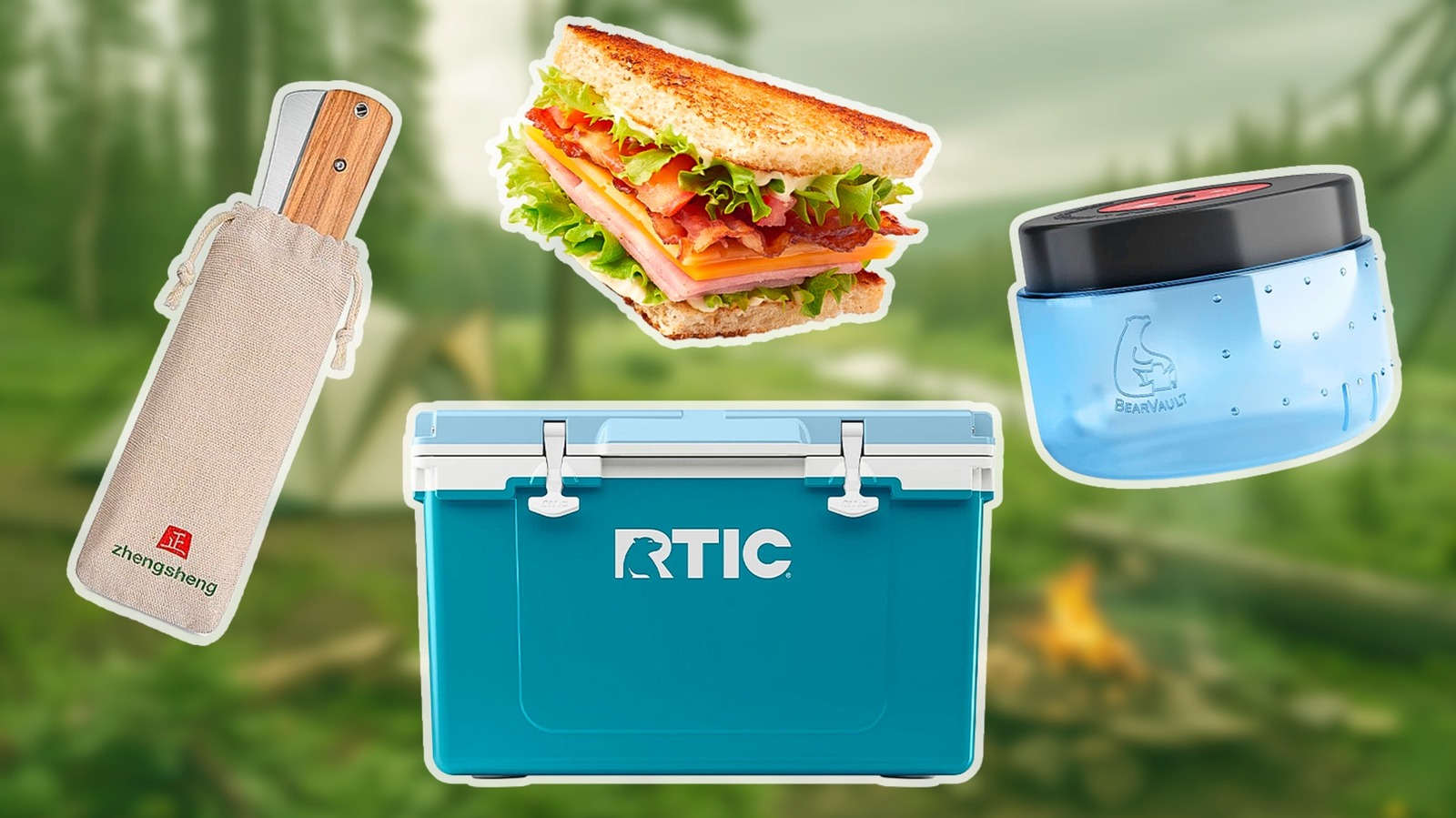We may receive a commission on purchases made from links.
When the days start getting longer and the mountains and rivers are calling your name, that can mean only one thing: It’s camping season. After spending days on end outside without refrigeration, electricity, or plumbing, those new to camping will quickly learn that it’s a whole lot more involved than just spreading out a blanket and sleeping under the stars. Before you can pack up the truck and head out into the backcountry or get the family nestled into their tents on the campground, there are a few things to learn to keep your trip safe and fun sans all the conveniences of life indoors.
Most of the difficulties of camping revolve around food. However, if you know how to pack and store everything edible, cooking and eating at camp can be one of the best parts of the experience. I’ve spent years as an avid outdoorsperson and camper, traveling all over the U.S. to camp on both established campgrounds and in the backcountry. I’ve learned through trial, error, and plenty of bear encounters what food to pack, how to store it, and how to keep it fresh for longer, so I rounded up this list of tips to make your experience fun and stress-free. So, let’s ditch our TVs and computers, grab plenty of s’mores supplies, and dive into some must-know tips to stay fed, happy, and bear-free at camp.
Just like you would when storing food at home in case of an emergency, prioritizing calorie dense foods at camp is key. In nature, you’ll undoubtedly be burning more calories than you would be at home on the couch or sitting at the office. Whether you’re hiking to a remote campspot in the mountains, kayaking, swimming, or just keeping warm on a cold night, calorie-dense foods are the fuel that keeps the passion for the great outdoors burning.
High-calorie foods also take up less space — when camping, any opportunity to save space is like manna from heaven. Think about it this way: One single-serving package of nuts contains roughly the same amount of calories as a whole bag of mixed greens. Meanwhile, one fits in your pocket but the other would take up an entire section of your cooler.
Opt for high calorie — but nutritious — grab-and-go snacks like trail mix, low-sugar granola bars, dried fruit (stick with no-sugar-added), and seeds like pepitas and sunflower seeds, which contain way more protein than you might realize. When planning for full meals to cook on the campsite, pack ingredients that will keep you full and energized for longer, especially if you plan on getting a lot of exercise on your trip. Carbs like whole grain pasta, rice, and bread are a filling base for any meal and are easy to keep fresh. Supplement a carb-heavy dinner with proteins like meat, fish, tofu, or beans — all of which can be cooked over a campfire.
Keeping things simple, especially if you’re new to making meals at camp, is always the way to go. Cleaning up after prepping a huge, intricate meal in the wilderness is a pain — trying to clean dishes with no running water always has me pining for my dishwasher back home. So, when planning out the menu for your trip, stick with one-pot meals or dishes that require minimal equipment.
My favorite camping recipes are simple, foil packet meals. Pick a couple veggies — I often choose corn and baby potatoes — and a meat — chicken or fish works well — then season everything, add butter or oil, and wrap each individual portion in heavy-duty foil. Then, stick it in the coals near the fire. After roughly 30 minutes, you’ll have a tender, flavor-packed dish ready to eat and minimal clean up afterwards.
If the idea of cooking a whole meal from scratch at camp has you shaking in your hiking boots, there are always pre-made, freeze-dried camping and backpacking meals to save the day. While they tend to be much pricier per serving than buying ingredients and cooking, the convenience is unmatched. All you have to do is add hot water and wait a few minutes and a piping hot, fresh-tasting dinner is waiting for you. Clean-up is easy (you can eat most of these meals right out of the bag they come in) and they’re designed for backpacking, so they’re lightweight and easy to pack.
Once you make it to camp, you might be tempted to start unpacking all of your food immediately, leaving bags of snacks right on the ground for easy reaching. But even if your food is in bags or containers, it’s a good idea to keep it away from the forest floor. Bugs and rodents can find their way into bags of food in a heartbeat, so putting significant space between the ground and your snacks is crucial, lest you create a meal for all the creepy crawlies of the woods.
Consider packing a folding table to keep food on if you’re driving up to your campsite. Keep the table in a shady spot under a tree so that food doesn’t spoil from sun exposure. If you’re backpacking, tacking on the extra weight of a folding table just for your food might be a bit superfluous, so consider hanging your food in a tree instead. Once you’re done eating, pack food in a hanging bear bag from Foilswirl and toss it in a tree at least 100 feet away from your campsite. This method makes it less likely that bears and other pests can help themselves to your leftovers.
It’s nice to know that there’s zero chance of going hungry, but of all of the trials and tribulations that come with a camping trip, overpacking food is one of the most annoying yet easiest to avoid. Normally, having a little extra food isn’t a bad thing, but when camping, saving space or weight should be prioritized over packing extras and luxuries.
If you’re having trouble gauging how much food you and your friends or family will likely eat during your trip, try pre-portioning meals and snacks at home before you leave. If you bought large trail mix packages, separate them into small, single-serving bags for you and your crew to grab before a hike or reach for at camp. Or, make your own nuts, candy, and dried fruit concoction and portion them out into bags before you leave for the wilderness.
For lunches and dinners, separate the ingredients for each day’s meals into labeled and dated containers and leave any excess ingredients at home. Make sandwiches in advance, instead of bringing whole packages of deli meat or containers of peanut butter and an entire loaf of bread. The more food you bring, the more clean-up and storage preparation is required, so only bring what you’re sure will be eaten. If you want to pack a little extra for emergencies or for unexpected calorie-burning activities, stick with calorie-dense, low-volume foods like nuts as your backup supply.
If there’s only one tip from this list that you can recall when packing for your upcoming trip, then let it be this one. Improper packing of food by campers in bear country has devastating effects on the cleanliness of the park and the safety of humans and bears alike. Once bears get a taste for human food, they’ll continue to seek it out, slowly weakening their ability to forage for natural food, becoming unhealthy, and putting their lives and the safety of campers at risk.
You might think that packing food away in a cooler or in your car and calling it a day can keep the bears away, but you’d be severely underestimating the bear. Bears, with the sharpest noses in the entire animal kingdom, are thought to be able to smell food that’s an astonishing 18 to 20 miles away — even just a few crumbs — and they’re not too shabby at breaking into cars, either (I’m speaking from experience here). That’s why bear-resistant food containers — like BearVault’s containers — are so crucial at camp.
A bear-resistant container can withstand the force of a bear stepping and clawing at it for hours. They’re far more effective than hanging bags, since bears are great climbers, and they’re lightweight enough to carry in a backpack. On my last trip, a bear manhandled my BearVault, but the bear eventually left defeated, and I left with all my food and just a few scratches on my container. BearVault: one. Bear: zero.
Unless you’re staying on an established campground with dumpsters, there likely won’t be a garbage receptacle for throwing away all the camp trash you accumulate during your trip. Trash cans attract bears, so some state parks and camping areas go without, and in the backcountry, there obviously won’t be anyone wandering through the woods to pick up after you. That’s why many parks, trails, and camping areas are known as “pack it in, pack it out” or “leave no trace” areas. These terms refer to the act of bringing anything that came into the woods, mountains, or desert with you — and yes, that includes your garbage.
Have a plan for storing garbage and keeping it away from your fresh food. Bring along trash bags to keep all of your food packaging, scraps, and other camp trash, but remember to lock your garbage away in a bear container along with your fresh food when you’re in the backcountry or camping in a bear-prone area. Either bring along a separate bear-proof container for garbage, or pack your trash in a heavy-duty bag, where it can’t spill out onto your fresh food when packed tight into a container.
Never toss biodegradable food scraps around your camp, even if you’re not camping in bear country. Animals will eventually eat them, making them sick or dependent on humans. Animals that become dependent on human food can become aggressive in an attempt to get more of our sugary, fatty treats, which puts both campers and the animals at risk.
Leave no trace principles make dealing with trash a whole different beast than what we’re used to at home, where we have the luxury of tossing our old food and plastic away and never having to think about it again. At camp, you’ll likely need to keep all your trash with you, which means storing it away in your backpack or finding a spot for it among your gear and supplies. So, aiming for the least amount of waste possible while packing makes smart, practical sense.
Even small plastic packages can become a nuisance when they start to pile up. If you’re packing bags of jerky, granola bars, or nuts, consider taking them out of their packages before your trip and storing them in reusable containers. Then, once the snacks are eaten, you can clean the containers and store them away, limiting the amount of dirty food garbage that you have to lug around.
Alternatively, instead of packing multiple tiny bags of snacks or individual containers of ingredients for meals, try mixing them together in one large bag. Once the food is no more, repurpose the bag for all of your camp trash or dirty laundry. Keep snacks with tiny, individual wrapping — like candy — off of your packing list, since one tiny wrapper is easy to lose on the ground, and that’s all it takes to attract a bear.
For those who aren’t hitting the ol’ industry trail with just a backpack and the bare essentials in tow, a cooler is a slightly luxurious but very worthwhile piece of camp gear to toss in your truck. Cooking from-scratch meals at camp is a lot more doable when you have a cooler to rely on, especially if you plan on cooking meat or seafood and not just ingredients from a can. Plus, by your third lukewarm soda or beer, you might be ready to pack up and head home to your trusty fridge. But not all coolers are created equal, and overestimating a cooler’s abilities can have horrendous, food poisoning-level consequences.
Although they’re pricier than a cheap-o cooler from a big box store, a high quality cooler — like this fan favorite, ultra-light option from RTIC — guarantees that you’ll be stocked with fresh food. This cooler, along with other high quality options, can keep food and drinks cold for days on end, without needing to constantly be restocked with ice.
To keep food even fresher in your high-quality, insulated cooler, consider grabbing a separate cooler for drinks, especially if you’re camping with a large group. This way, the cooler full of food won’t be opened over and over, reducing the chances of food warming up and going bad. You can also freeze meats, seafood, and fresh veggies ahead of time if you don’t plan on using them within a day or two of arriving at camp to ensure they’ll last.
If you’re planning to cook at your drive-up campsite, you’ll need to bring more than just food. It’s easy to forget to pack items for a camping trip that we’re so used to thoughtlessly grabbing at home, like a cutting board and utensils, but a few forgotten pieces of equipment can lead to a whole lot of food for hungry people and no way to prepare it. However, you might not want to grab the same cooking equipment that you use at home.
Compact cooking gear goes a long, long way at camp. Instead of reaching for your trusty chef’s knife — which can be dangerous when taking it on the go — grab a folding chef’s knife, like one from ZhengSheng, which is designed for safety and convenience. To save space and make cooking outdoors-friendly, opt for things like nesting cookware, miniature spice containers (you can even fill Tic-Tac containers with spices), and an all-in-one French press from Stanley.
Remember to stick with only necessities, repurposing tools as often as you can so you can bring less. For example, one cast iron Dutch oven can bake biscuits, simmer a sauce, sear steaks, and make chili, so pack just this tool as opposed to multiple pots and pans. Use your French press carafe to boil water for freeze-dried meals and your campfire tongs for stirring a stew.
Once the sun settles beyond the mountains and the crickets start chirping, it’s time to think about gathering up all the food and garbage and putting it away for the night. I recommend packing everything up before last light, otherwise, it’s easy to miss a stray wrapper or chunk of uneaten food that can act as a hungry bear homing beacon while you’re asleep. You should never eat inside or right outside your tent, but just in case, check the tent and the surrounding area thoroughly for any food remnants before settling in for the night.
Those in the backcountry should pack everything away, including food wrappers that look clean, into a bear-proof container or hanging bear bag and put it at least 100 feet away from camp, ideally downwind. If you’re using a bear bag, make sure to hang it from a limb that’s at least 12 feet off the ground in a spot that’s at least six feet away from the tree’s trunk to prevent a climbing bear from reaching it. Those with coolers at drive-up sites in bear country should walk their cooler, preferably with a bear lock on it, at least 100 feet from camp, or stow it away in their cars, as long as no one is sleeping inside and the car isn’t close to any tents.




